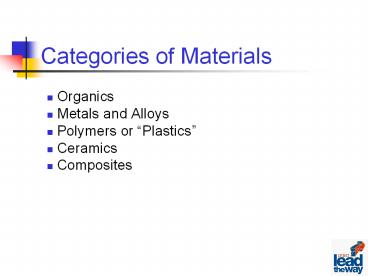Categories of Materials - PowerPoint PPT Presentation
1 / 18
Title:
Categories of Materials
Description:
Categories of Materials Organics Metals and Alloys Polymers or Plastics Ceramics Composites Organics Organics are or were living organisms Composed of mostly ... – PowerPoint PPT presentation
Number of Views:172
Avg rating:3.0/5.0
Title: Categories of Materials
1
Categories of Materials
- Organics
- Metals and Alloys
- Polymers or Plastics
- Ceramics
- Composites
2
Organics
- Organics are or were living organisms
- Composed of mostly carbon and Hydrogen
- Structure depends on the way cells develop, not
by human manipulation - Renewable, sustainable
- Infinite variety
- Genetically alterable
3
Organics-Wood
- Hardwood- Deciduous, tend to be harder and more
expensive - Softwood- Conifers, tend to be softer and cheaper
- Plywood- Much stronger and dimensionally stable
- Engineered Beams- Construction only
- Oriented Strand Board and MDF- Dimensionally
stable and cheap
4
Metals and Alloys
- Metals are pure elements which comprise about
three-fourths of the periodic table - Few are used in their pure form because of
- Hardness too hard or too soft
- Cost scarcity of element
- Engineers need certain characteristics that can
only be accomplished by a blending of elements - Metals are malleable, reflective, and
electrically conductive material - They are excellent conductors of electricity and
heat
5
Metals
- Possess material properties, including
- high strength and toughness
- high electrical conductance
- high thermal conductance
- luster
- Examples
- aluminum - copper - gold - zinc - iron - lead -
nickel - silver - thorium - chromium - tin - beryllium
6
Alloys
- Consist of materials composed of two or more
elements, at least one being a metal - This combination of elements gives the material a
combination of properties from each element - Examples
- Steel- iron, carbon and impurity elements such as
boron copper or silicon - Brass - copper, zinc
- Stainless Steel - nickel,iron
- Monel - nickel,copper
7
Types of Metallics
- Ferrous Metallics - iron and alloys which contain
at least 50 iron (e.g. wrought iron, cast iron,
steel, stainless steel) - Nonferrous Metallics - Metallic elements other
than iron (e.g. copper, lead, tin, zinc,
titanium, beryllium, nickel) - Powdered (Sintered) Metals (ferrous or
non-ferrous) - Sometimes called sintered metal. A process of
producing small (powdered) particles which are
compacted in a die and then sintered (applying
heat below the melting point of the main
component) - Examples
trigger on gun, gears, bearings,
carbide tool inserts
8
Polymers
- Polymers
- Chain-like molecule made of many (poly) smaller
molecular units (monomers) - Chaining (polymerization) is responsible for the
formation of natural fibers, wood, lignin,
rubber, skin, bone and the tissues of animals,
humans and insects
9
Plastics
- Plastics
- Human-made polymers
- Plastics are workable or moldable
- Thermosetting plastics are formable once (e.g.
epoxy, phonelic (Bakelite), polyurethane) - Thermoplastics can be heated repeatedly and
- formed into new shapes (e.g. polyethylene,
nylon, Plexiglas)
10
Elastomers
- Elastomer
- amorphous (shapeless) structure consisting of
long coiled-up chains of entangled polymers - can be stretched at room temperature to at least
twice its original length and return to its
original shape after the force has been removed - Process to strengthen an elastomer vulcanization
- a chemical process used to form strong bonds
between adjacent polymers to produce a tough,
strong, hard rubber (automobile tires)
11
Ceramics
- Crystalline compounds combining metallic and non
metallic elements - The absence of free electrons make ceramics poor
electrical conductors. - Because of the strength of the bonding, ceramics
have high melting temperatures
12
Ceramics(continued)
- Categories
- Clay
- Refractory
- Electrical and Magnetic
- Glasses
- Cermets
13
Ceramics(continued)
- Clay Products
- Inorganic material which is shaped, dried and
fired. - Examples brick, floor and wall tiles, drainage
tile, roof tile, sewer pipe, chimney flue, china,
and porcelain.
14
Ceramics(continued)
- Refractory Materials
- Ceramics designed to provide acceptable
mechanical or chemical properties while at high
temperatures. - Most are based on stable oxides such as carbides,
nitrides, and borides. - An example of a refractory is the machinable
all-silica insulating tiles on the U.S. space
shuttle
15
Ceramics(continued)
- Electrical and Magnetic Applications
- Ceramics are used as resistors and heating
elements for furnaces (silicon carbide) - Semiconductor properties
- Thermistors- as they heat-up allow current to
flow. - Rectifiers- allow current to flow in one
direction - Clay based ceramics for high-voltage insulators
16
Ceramics(continued)
- Glass
- Based on silica with additives that alter the
structure or reduce the melting point, optimize
optical properties, thermal stability and
resistance to thermal shock
- Cermets
- Combinations of metals and ceramics(oxides,
nitrides, or carbides) bonded together in the
same way powdered metallurgy parts are made. - Examples crucibles, jet engine nozzles
17
Composites
- Laminar or Layer Composites - alternate layers of
materials bonded together. (e.g. plywood, safety
glass, Formica, bimetallic strips) - Particulate Composites - discrete particles of
one material surrounded by a matrix of another
material. (e.g. concrete, asphalt, powdered
metals and ceramics) - Fiber-Reinforced Composites - composed of
continuous or discontinuous fibers embedded in a
matrix of another material. (e.g. Kevlar, rayon,
steel reinforced tires, fiberglass,
graphite-epoxy)
18
Review
Major Categories of Materials
- Organics
- Metals and Alloys
- Polymers
- Ceramics
- Composites

